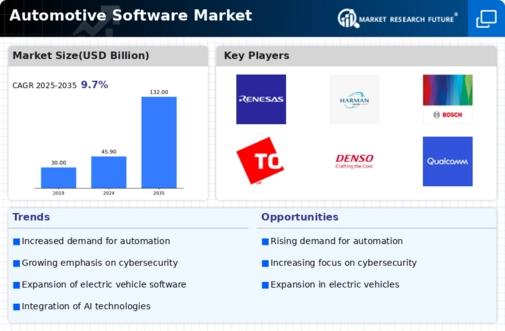Top Industry Leaders in the Automotive Software Market
*Disclaimer: List of key companies in no particular order
Dynamics of the Automotive Software Market: Leading Players, Strategies, and Emerging Trends
The Automotive Software Market is undergoing rapid transformations, driven by the escalating adoption of advanced technologies such as autonomous driving, connectivity, and electrification. This dynamic environment has led to intense competition among both established players and new entrants seeking a slice of the market share. A profound understanding of the competitive landscape is imperative for navigating this intricate market and making well-informed decisions.
Automotive Software Key Players and Strategic Approaches:
Prominent players such as NXP Semiconductors (Netherlands), BlackBerry (Canada), Renesas Electronics Corporation (Japan), Elektrobit (Germany), NVIDIA Corporation (US), Microsoft Corporation (US), Airbiquity Inc. (US), Green Hills Software (US), Autonet Mobile, Inc. (USA), and Wind River Systems dominate the automotive software market, each wielding distinct strengths and strategies. The key players can be categorized into:
-
Tier 1 Suppliers: Established companies like Bosch, Continental, and Denso leverage their strong relationships with automotive OEMs and expertise in hardware development to provide comprehensive software solutions.
-
Tech Giants: Companies such as Google, Microsoft, and Amazon leverage their technological prowess in cloud computing, artificial intelligence, and data analytics to innovate software solutions for connected cars and autonomous driving.
-
Automotive Software Specialists: Companies like Elektrobit, Luxoft, and KPIT specialize in developing specific software solutions for various automotive applications, including ADAS, infotainment systems, and powertrain control.
-
Startups: New entrants constantly emerge, bringing fresh perspectives and disruptive technologies to niche areas like cybersecurity, V2X communication, and personalized user experiences.
Factors Influencing Market Share:
Several factors play a pivotal role in determining market share dynamics in the automotive software market. These include:
-
Product Portfolio and Technology Leadership: Companies boasting a comprehensive portfolio of software solutions and cutting-edge technologies tend to attract more customers and gain market share.
-
Partnerships and Collaborations: Strategic partnerships with OEMs, technology companies, and other ecosystem players significantly enhance market reach and access to resources.
-
Pricing and Business Model: Offering competitive pricing models and flexible licensing options can attract customers and drive market share growth.
-
Innovation and R&D: Continuous investment in research and development is crucial for staying ahead of the curve and developing solutions that meet evolving customer needs.
-
Global Presence and Regional Focus: Having a strong global presence and focusing on key growth regions can help companies capitalize on new market opportunities.
New and Emerging Trends:
Several emerging trends are reshaping the competitive landscape of the automotive software market:
-
Open-Source Software and Collaboration Platforms: Platforms like Automotive Grade Linux (AGL) are gaining traction, fostering collaboration and innovation among industry players.
-
Cloud-Based Solutions: The increasing adoption of cloud computing enables faster deployment, scalability, and cost-effectiveness of automotive software solutions.
-
Cybersecurity and Data Privacy: With growing data collection and connectivity, cybersecurity and data privacy are becoming critical concerns, leading to the development of robust security solutions.
-
Over-the-Air (OTA) Updates: OTA updates enable software updates and bug fixes without physical intervention, enhancing user experience and improving vehicle performance.
-
Personalized User Experiences: Automotive software is increasingly focused on providing personalized user experiences tailored to individual preferences and driving behavior.
Overall Competitive Scenario:
The competitive landscape of the automotive software market is expected to remain dynamic. Established players will leverage their resources and expertise, while new entrants will strive to disrupt existing markets with innovative solutions. Collaboration and partnerships will be key for companies to thrive in this complex environment.
Key Takeaways:
- The automotive software market is highly competitive, with established players and new entrants vying for market share.
- Factors influencing market share include product portfolio, technology leadership, partnerships, pricing, and global presence.
- Emerging trends like open-source software, cloud-based solutions, and personalized user experiences are shaping the competitive landscape.
- Collaboration and adaptability will be crucial for companies to succeed in the dynamic automotive software market.
Industry Developments and Latest Updates:
- NXP Semiconductors: Collaborates with BlackBerry QNX on a secure vehicle-to-everything (V2X) platform for autonomous driving systems. (October 27, 2023: NXP press release)
- Elektrobit: Develops an autonomous driving software suite with embedded artificial intelligence (AI) for Level 4 autonomy. (October 27, 2023: Elektrobit website)
- NVIDIA Drive Orin: Starts production for the next-generation automotive AI compute platform for autonomous vehicles. (October 27, 2023: NVIDIA press release)
- Microsoft: Announces Azure Digital Twins for Connected Vehicles to simplify car data management and analytics. (October, 2023: Microsoft Azure blog)
- Airbiquity: Partners with Stellantis to provide over-the-air (OTA) software updates for electric vehicles. (October, 2023: Airbiquity press release)
- Green Hills Software: Releases INTEGRITY real-time operating system (RTOS) for safety-critical automotive applications like ADAS and powertrain control. (October, 2023: Green Hills Software website)










